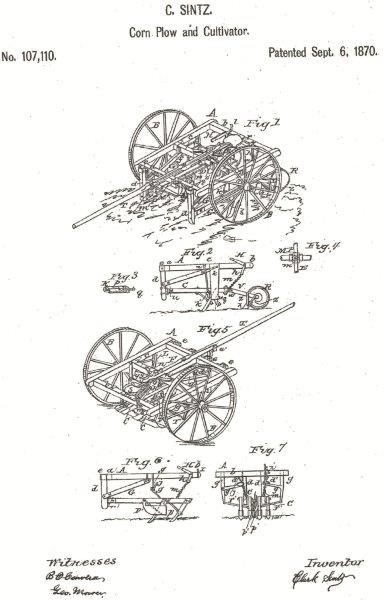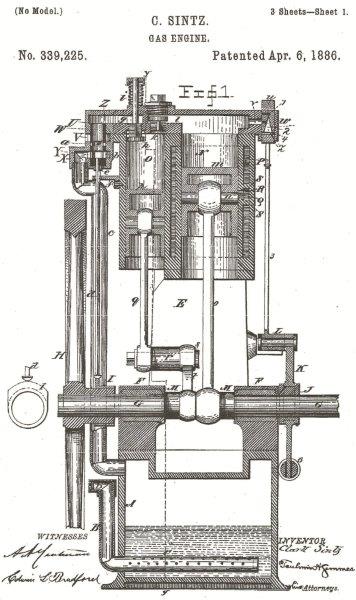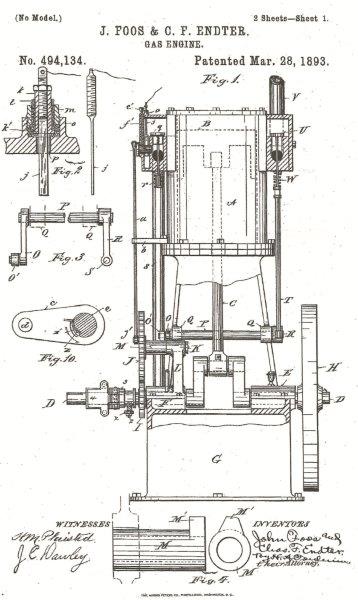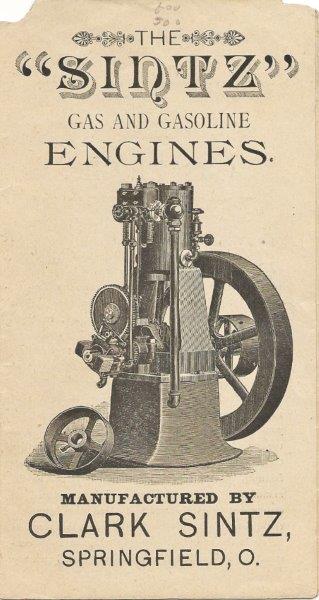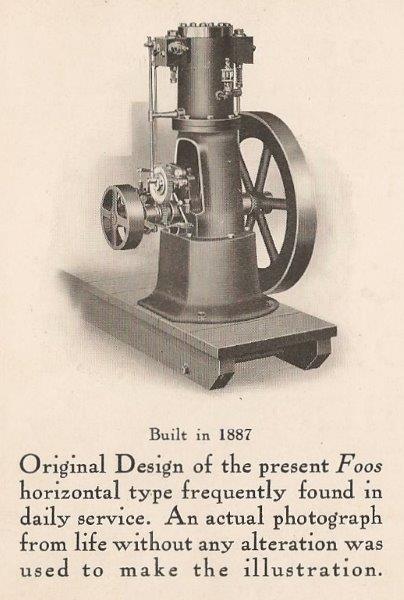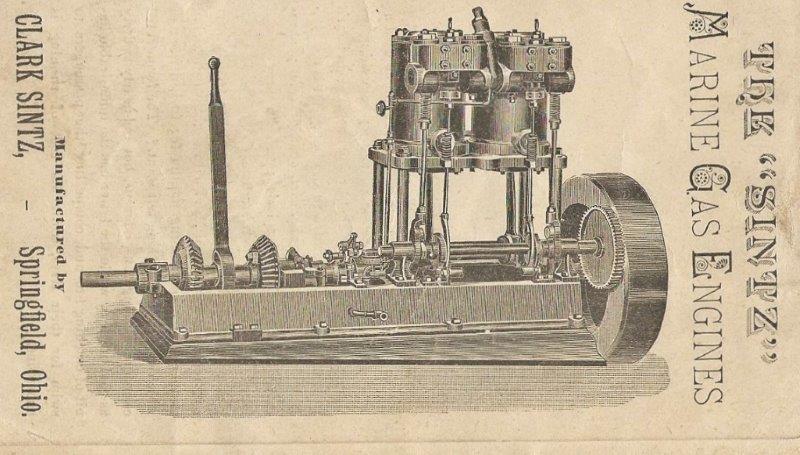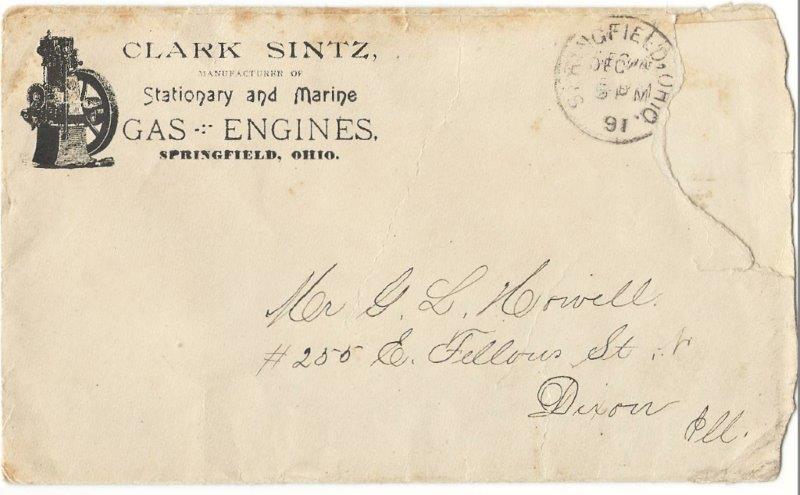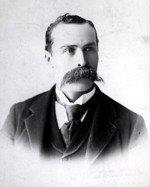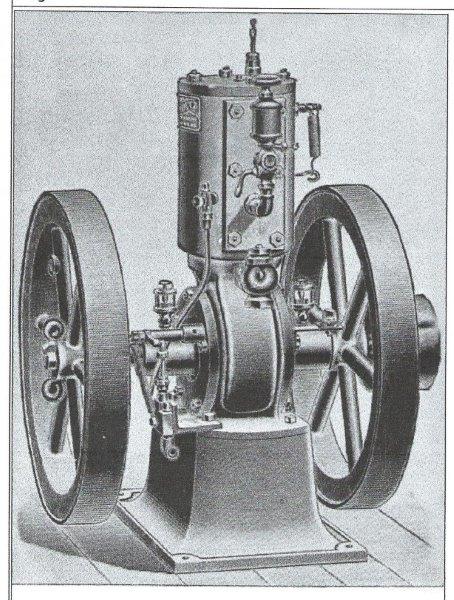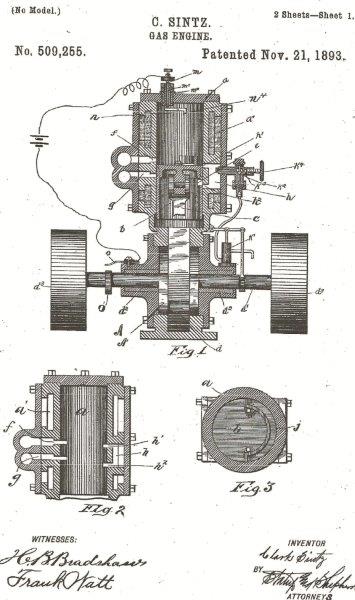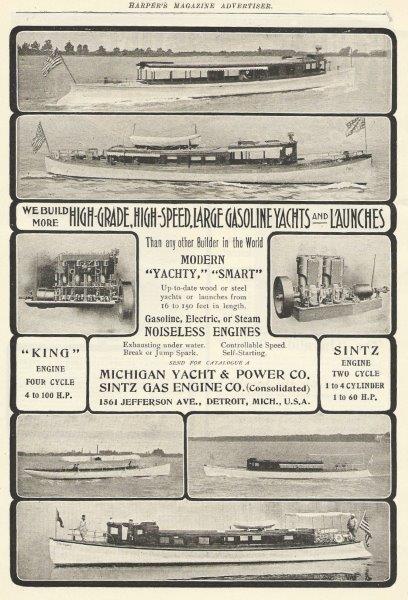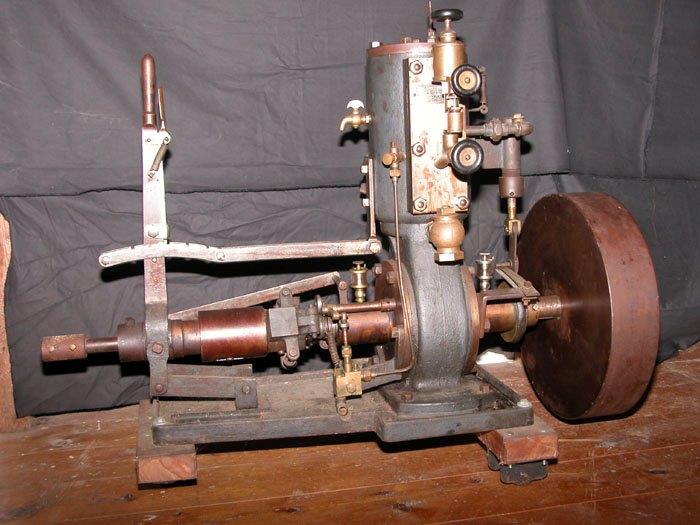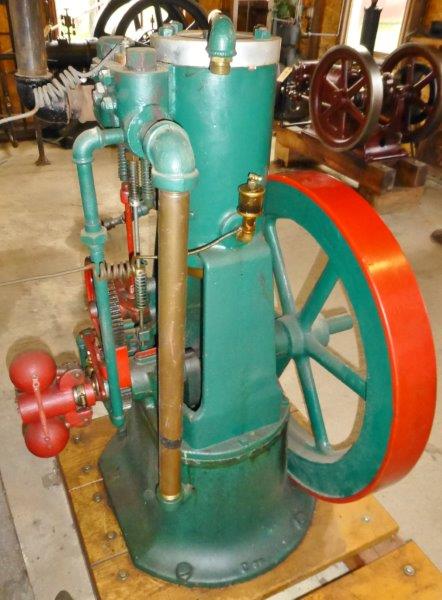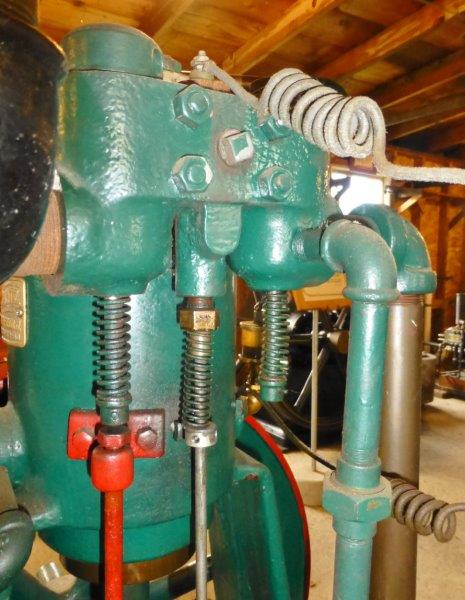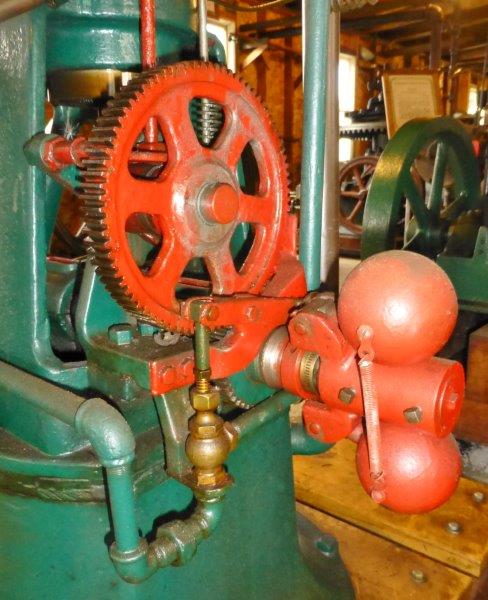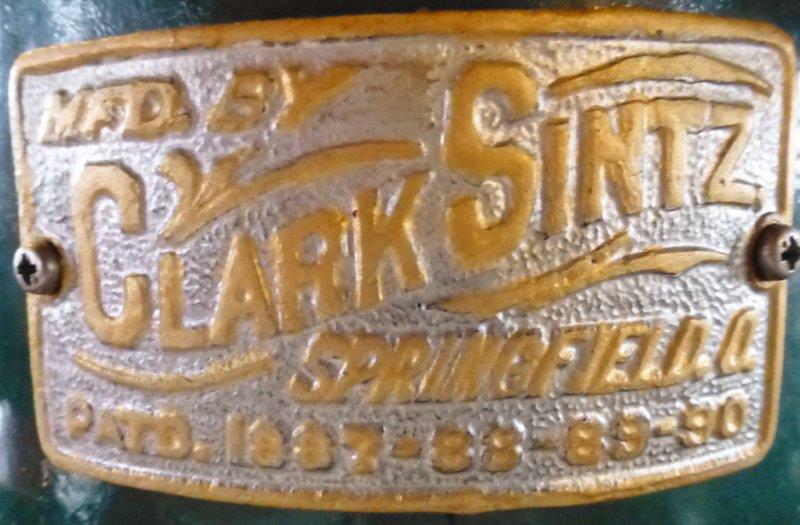|

January 2015
Clark Sintz: The Early Years
By
Paul Harvey
Beginning my fifth year of writing the monthly
Flywheel articles, I chose the rare and obscure Clark Sintz engine
located in the Founders Engine House at Coolspring Power Museum. At
first, fearing that little information would be available, I soon became
overwhelmed with the detailed story of this ingenuous inventor, deciding
to make this a two-part article. Researching Clark Sintz on
Ancestry.com,
I became acquainted with Bob Sintz, Clark's
great-grandson. I am indebted to him for all the information and
dialogue that he provided, some of which is used in this article. This
month, I will present a discussion of Clark's early years in
Springfield, Ohio, followed next month by his later career in Grand
Rapids, Michigan, and New Orleans, Louisiana. And so, our fascinating
story begins.
Clark Sintz was born at his parents' farm located near
Springfield, Ohio, on
May 9, 1850. His grandfather had settled there in 1797.
Young Clark was an inventor from birth and, at age 12, he built a toy
steam engine from an old pistol barrel and copper tea kettle! In 1868,
he made a slide valve steam engine. When only 20 years old, he obtained
his first patent, number
107,110,
for a corn plow and cultivator. Refer to Photo 1.
In 1877, he built his own small machine and blacksmith shop and repaired
farm equipment locally. Here, he designed many novel devices to make
his work - as well as the neighboring farmers work - easier. He became
aware of the gas engine when learning about the Otto Gas Engine at the
Centennial Exhibition in Philadelphia
in 1876. Fascinated with this new power source, he started his first
experiments in 1883.
In 1874, according to the U.S. Census Records, he married Virgie
Littler, who became his lifetime companion. They resided in
Springfield, Ohio, where
he operated his shop and delved into gas engine experimentation and
design. He was indeed a pioneer in this venture, along with Charter of
Sterling, Illinois, and Van Duzen of Cincinnati,
Ohio. These men were on their own as there was
nothing to copy from - just try it and see if it works! While in
Springfield, two sons were born; Guy in 1875 and
Claude in 1876. They both followed their father's love for gas
engines. Together, they moved to Grand Rapids,
Michigan, in 1893, and that story will be told
next month.
Clark's first engine was patented in 1886, number
339,225,
and is shown in Photo 2. This was a two-cycle marine
engine using the Clerk cycle, which employed a separate charging
cylinder from the power cylinder. It was one of the very few American
engines to have open flame ignition. Apparently, it was successful as
it powered his boat for demonstrations, and amazingly it used gasoline
both for fuel and the ignition. It is unknown how many were built, and,
being so complicated, this could have been a prototype. Soon after, he
invented the electric "make and break" ignitor. As noted in patent
number
383,775 of 1888, it was a sliding spindle device, which eventually
became common with later builders in southwestern
Ohio. This feature greatly improved the
performance of his engines.
Although there are several different versions of the following story, I
have tried to compile the most reasonable. Sintz had an early
association with Charles Endter and John Foos, both of
Springfield. It seems that Sintz and Endter
designed a four-cycle gas engine which was then patented by Endter and
Foos. This patent of 1893, number
494,134,
is shown as Photo 3. Strangely, this engine was
being built and sold in 1891, perhaps even earlier. Together with
P.P. Mast of Springfield,
Sintz, Endter and Foos formed the Gas Engine Company in 1888 to develop
and produce a new engine. This patent appears to have been their result.
The Gas Engine Company lasted only until 1890 when Sintz sold out to
Foos. Foos continued with the well known Foos Gas Engine Company while
Clark formed the Sintz Gas Engine Company. Both claimed to
have made improvements of their own on the patent and to be building a
better engine than the other. There is no further mention of Mast's nor
Endter's involvement. So both Sintz and Foos produced very similar and
successful machines.
Photo 4, the Sintz four-cycle vertical engine and
Photo 5, the Foos four-cycle vertical engine are shown together
for comparison. The engine frames, the flywheel and crankshaft, and the
governor are identical. Sintz used a single valve chest on one side of
the engine with two vertical valves and the sliding spindle ignitor
between, while Foos utilized a "T" head design with valve chests on both
sides. This arrangement became so typical of all later Foos engines.
Sintz used his patented sliding spindle ignitor while Foos, with
Endter's help, developed their long-lasting "wipe spark" ignitor,
located on the side of the intake chest. Both of these competing
designs were successful. Clark expanded his
design by including a four-cycle, twin-cylinder marine engine as noted
in Photo 6. The two Sintz engine photos were from an 1891
brochure which was found in this envelope, Photo 7.
Short-lived, the Sintz four-cycle engines were made only in 1891 and
1892. The engine displayed at the Coolspring
Power Museum
was made during this era. It will be described in detail later in this
article. It is presumed that Endter's and Foos' influence turned
Clark away from the two-cycle design of his original engine,
for a trial of the four-cycle principle. By 1892, Clark, and the Sintz
Gas Engine Company, had returned to his first love, the two-cycle
engine. Although there was no navigable water near
Springfield, Ohio, his
main interest turned to marine engines. The firm did manufacture a two
flywheel stationary model as well. This venture seemed to prosper, and
the 1892 U.S. Cities Directories noted Clark
and his family living at 222 Cedar Street,
Springfield, and his firm located at
172 West North Street in
Springfield, Ohio. Always
on the move, the U.S. Cities Directories of 1893 notes that
Clark was now in Grand Rapids, Michigan, and was president and
superintendent of the Sintz Gas Engine Company. It was located at
242 Canal Street. This story will continue
in next month's article.
Photo 8 is Clark Sintz at the Colombian Exposition in
Chicago, Illinois, held in
1892 and 1893. Clark, who would be an unknown among the famous
inventors there, decided he would attend and make his presence known.
He transported a wooden vessel of his own manufacture, powered by his
two-cycle engine, and placed it in Lake Michigan
adjoining the big show. His boat and engine performed flawlessly and
soon he was giving executives and inventors tours of the
Chicago lakefront. His fame soon spread and he
gained this portrait as well as many significant contracts for his
engine. This was the beginning of his relationship with the Michigan
Yacht Club and a successful future in Grand Rapids.
While still in Springfield,
Clark resumed his research and design of a dependable,
two-cycle, gasoline engine. A stationary version of this development
was featured in Cassier's Magazine in 1893. This handsome and
successful engine is shown as Photo 9. Sintz had a total
of 17 patents but his most important one was number
509,255
of November 21, 1893.
Seen in Photo 10, it is his three port, gasoline injected
engine, which utilized a piston tripped electric ignitor. Apparently
different enough from Joseph Day's patent in
England, there was no infringement.
This design used no valves and scavenged the intake air through the
piston. The fuel injector was in the cross-over port and the rapid air
flow inducted the fuel. This design became the standard of so many
two-cycle engines still built today. He now had an engine that would
sustain both his marine and automotive ambitions.
Looking ahead a bit, Photo 11 is a Sintz advertisement of
1902 as shown in Harper's Magazine. At that time, the company,
then in Grand Rapids,
Michigan, was very successful. Clark
must have been very happy to see his two-cycle engine made in so many
sizes and offered in so many launches and yachts! Unfortunately, very
few of Clark Sintz's marine engine still exist today. Photo 12
shows a beautifully restored example on display at the
Penobscot
Marine Museum
in Maine. Note the lever
that controls both the pitch of the propeller and the governor.
Moving ahead a century or so, I will detail and describe the Clark Sintz
engine displayed at Coolspring
Power Museum.
Located in the Founders Engine House, this engine is shown in
Photo 13. It was manufactured in 1891, and, to my knowledge, is
the only four-cycle Sintz engine existing. I purchased the engine at an
auction of the contents of a tumbledown shop near the
Allegheny River in Freeport,
Pennsylvania, in 1971. Recognizing it as a very
old engine, one unknown to me, I was able to purchase the frame with
crankshaft and wheel for $3.00!! These parts just have to be
significant! After the auction, I was permitted to search the piles of
junk for parts, and was rewarded by finding the head and valve chest, as
well as several other small parts. It appeared more like an engine
then. However, it languished at Coolspring for many years before it was
"restored." Not knowing the exact appearance of the missing parts, they
were fabricated to appear correct and to be functional. The job went
amazingly well and the engine now runs.
Photo 14 details the valve chest on the
museum's engine. Note the power operated exhaust valve to the left
which operates from a cam. The reconstructed sliding spindle ignitor,
in the center, has an intricate trip mechanism that is activated by the
cam shaft. The atmospheric intake valve is to the right, and shows both
the gas and air pipes entering the mixer. The pipe sizes suggest that
this engine was intended to operate on gas and not gasoline. Photo
15 shows the timing gears, governor, and fuel valve. The timing
gear and gas valve are original, found in the junk pile, but the
governor has been reconstructed. Finally, Photo 16 is the
original and ornate brass name plate. Note that the last patent listed
is 1890!
This concludes the story of the early years of Clark
Sintz in Springfield, Ohio.
Next month will continue with the rest of his career.
Coolspring
Power Museum
is now closed for the winter but tours can still be arranged by
advance notice. Please call 814-849-6883 or see our web site at
www.coolspringpowermuseum.org for events and developments. See you
then!
|

